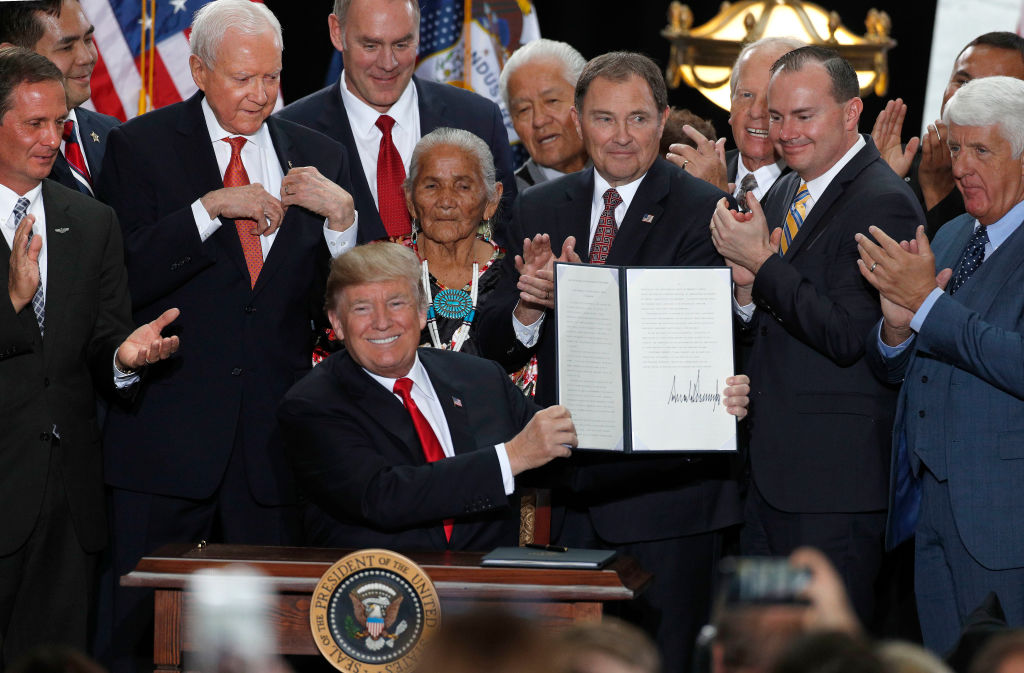President Trump signed two proclamations Monday that shrink federally protected lands in Utah by about 2 million acres — the largest rollback of national monument designations in history.
The Bears Ears National Monument will shrink 85% to 201,876 acres, and the Grand Staircase-Escalante National Monument will be cut by 39% to 1 million acres.
The proclamations effectively split the two vast swaths of federally protected lands into five much smaller monuments. The changes take effect in 60 days.
Trump's decision to scale back the size of those monuments marks the most aggressive presidential effort to roll back national monument protections in U.S. history. In addition to shrinking the size of the two monuments, Trump also lifted restrictions on motorized vehicles and livestock grazing even within the smaller boundaries.
The move was met almost immediately by a lawsuit from The Wilderness Society and nine other environmental groups, who claim that Trump exceeded his authority and "flouted 111 years of conservation history."
Trump portrayed the move as a victory for states' rights and local control, but conservation groups called it the beginning of "open season" on federal lands.
Trump said previous presidents overstepped their authority in declaring vast tracts of western lands off-limits, abusing the "purpose, spirit and intent" of a 1906 law known as the Antiquities Act. That law requires presidents to limit the monument designation to "the smallest area compatible with proper care and management of the objects to be protected."
"These abuses of the Antiquities Act give enormous power to faraway bureaucrats at the expense of the people who actually live here, work here, and make this place their home," Trump said in Salt Lake City Monday.
"With the action I’m taking today, we will not only give back your voice over the use of this land, we will also restore your access and your enjoyment. Public lands will once again be for public use, because we know that people who are free to use their land and enjoy their land are the people most determined to conserve their land," he said.
Secretary of the Interior Ryan Zinke had recommended that Trump vastly reduce the size of the monuments and seek congressional authorization to turn over the remaining landmarks to be co-managed with Native American tribes.
The recommendation came as a result of an executive order Trump signed in April asking for a review of his predecessors' use of the Antiquities Act to designate federal lands as national monuments. That designation can protect those lands from development, mining and drilling.
Zinke said his review looked at 150 monuments, with 27 getting the most scrutiny. The details of that report will be released Tuesday, he said.
But tribal groups called Trump's action a "shameful attack" on lands considered sacred to American Indians. “Bears Ears isn’t just about a few artifacts in isolated locations,” said Shaun Chapoose, a member of the Ute tribe, which advocated for the creation of the monument in the 1990s. “The Bears Ears region is a cultural landscape – a place to nurture our families in our traditions."
Tribal and environmental groups have condemned the decision and promised to fight it in court, questioning whether the president can rescind a national monument without an act of Congress. The last president to use his power to reduce the size of a monument was John F. Kennedy in 1963.
Unlike national parks, which are established by Congress, the Antiquities Act allows national monuments to be designated either by Congress or the president. President Barack Obama was particularly active in designating new and expanded monuments, bringing more land and water under federal protection than any president in history.
The Bears Ears National Monument, designated by Obama by proclamation a year ago, currently encompasses 1.35 million acres in southern Utah, including the distinctive twin mesas that give the monument its name. The Bears Ears and surrounding sites are considered sacred to many American Indian tribes.
The other monument Trump is targeting, the Grand Staircase-Escalante National Monument, was designated by President Bill Clinton in 1996. The site in southern Utah contains a series of escalating canyons and gorges, and at 1.7 million acres is the largest land area designated as a national monument.
But Zinke said he will also recommend changes to a handful of other monuments. Zinke said his review looked at 150 monuments, with 27 getting the most scrutiny. The details of that report will be released Tuesday, he said.
With typical Trumpian flair, the president had hyped the announcement as "one of the great, really, events in this country in a long time." He made the announcement at the Utah State Capital, with a proclamation signing ceremony that included state and federal lawmakers.
Outside, protesters held signs saying "Trump a monumental mistake" and "Tiny hands off our lands."
Earlier, Trump met with Mormon leaders of the Church of Jesus Christ of Latter-Day Saints, and toured Welfare Square, the Mormon social services complex during his first trip to Utah as president.


